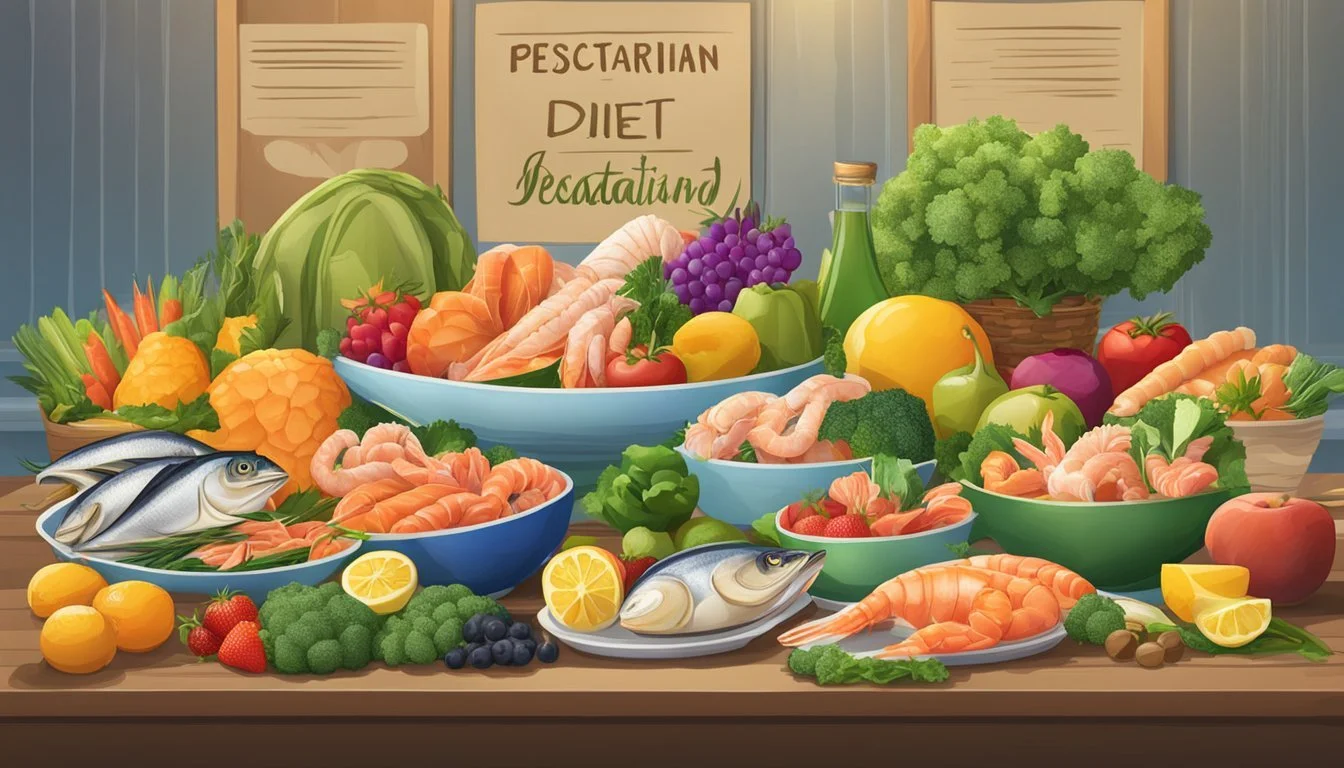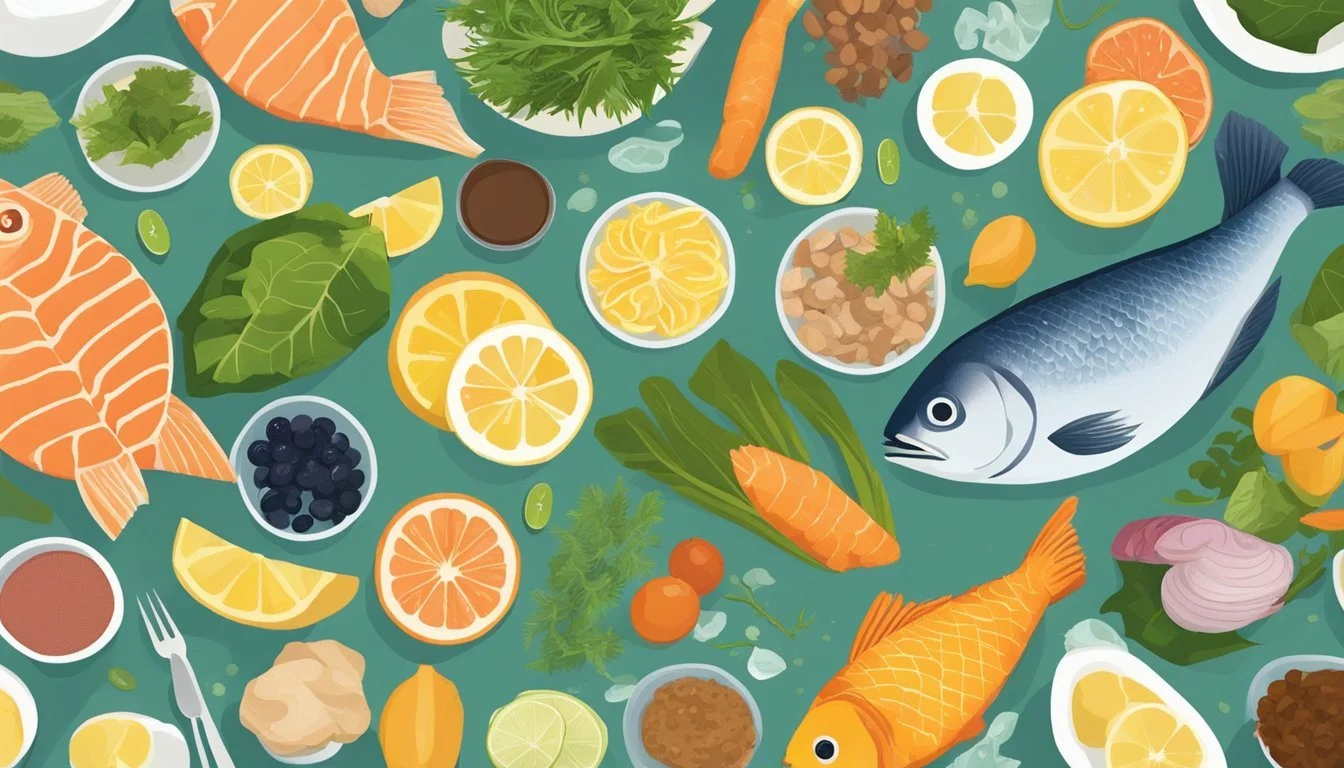The Truth About the Pescatarian Diet
Unveiling Its Health Benefits and Considerations
The pescatarian diet combines the principles of vegetarianism with the inclusion of seafood (What wine goes well with seafood?), providing a dietary pattern that is rich in plant-based foods and fish. Proponents often cite its potential benefits for heart health, due to a high intake of lean proteins, omega-3 fatty acids, and a foundation of fruits, vegetables, and whole grains. It's a dietary choice that some individuals make with a view towards improved health outcomes, environmental considerations, and ethical concerns regarding land animal husbandry.
Critically examining the pescatarian diet reveals its alignment with dietary guidelines that emphasize a reduction in red meat consumption and an increased intake of nutrient-dense foods. However, while touted for its potential health benefits, it is important to consider the diet's nutritional completeness and the quality of seafood consumed. Sustainability and mercury content are among the factors that inform the choice of seafood within a pescatarian diet, which can significantly impact its healthfulness.
As with any diet, balance and variety are key to ensuring that all nutritional needs are met. Individuals following a pescatarian diet are encouraged to include diverse sources of plant proteins, grains, nuts (What wine goes well with nuts?), and seeds, to complement the nutrients provided by fish and seafood. The balance struck between these elements is what can potentially make the diet a healthy way to eat, affecting the overall wellness of those who adhere to its principles.
The Pescatarian Diet Defined
The Pescatarian Diet amalgamates vegetarian principles with the inclusion of seafood, offering a plan rich in plant-based foods supplemented with aquatic protein.
Core Principles of a Pescatarian Diet
In essence, a pescatarian diet is built around the consumption of fish and other seafood, acting as the primary source of animal protein. This diet supports the inclusion of a variety of fruits, vegetables, legumes, nuts, and seeds, encouraging a nutrient-rich intake. While eggs and dairy products are also permitted, the pescatarian diet's hallmark characteristic is its reliance on seafood, such as:
Fish (for example, salmon, (What wine goes well with salmon?) trout, and herring)
Shellfish (What wine goes well with shellfish?) (like shrimp, clams, (What wine goes well with clams?) and mussels) (What wine goes well with mussels?)
Individuals often choose this dietary approach for its nutritional benefits, which are founded on a high intake of lean protein, omega-3 fatty acids, and essential nutrients derived from both plant and sea sources.
Key Differences from Vegetarian and Vegan Diets
The pescatarian diet often gets confused with vegetarian and vegan diets due to their plant-based emphasis. However, the key differences lie in the animal products consumed:
Vegetarian Diet: Typically excludes all meat and seafood but may include eggs and dairy.
Vegan Diet: Excludes all animal products, including dairy, eggs, and honey.
Conversely, pescatarians include seafood, distinguishing their diet from both vegetarianism and veganism. They benefit from the nutritional components found in fish, such as omega-3 fatty acids, while still enjoying the healthful properties of a plant-forward diet. The table below illustrates the dietary inclusions:
Pescatarian Diet Vegetarian Diet Vegan Diet Fish & Seafood Yes No No Eggs Yes (optional) Yes (optional) No Dairy Yes (optional) Yes (optional) No Plant-based Yes Yes Yes
The pescatarian diet provides a middle ground, offering flexibility and variety in one's eating pattern. It accommodates individuals looking to exclude land-based meats from their diets while still reaping the nutritional advantages from the ocean.
Health Benefits of Pescatarianism
The pescatarian diet is associated with numerous health benefits, particularly due to its emphasis on heart-healthy omega-3 fatty acids and lean protein from fish, alongside a plethora of plant-based foods.
Heart Health and Omega-3 Fatty Acids
Omega-3 fatty acids, particularly EPA (eicosapentaenoic acid) and DHA (docosahexaenoic acid), are abundant in fish and are linked to reduced risk of heart disease. The pescatarian diet, with its rich inclusion of fish, can lead to an increased intake of these essential fats. Research suggests that these omega-3 fatty acids can improve cardiovascular health by:
Lowering triglycerides: Elevated triglyceride levels are a risk factor for heart disease.
Reducing blood pressure: High blood pressure is a known risk factor for heart attacks and strokes.
Impacts on Diabetes and Blood Pressure
Individuals with or at risk for type 2 diabetes may benefit from a pescatarian diet due to its potential to improve blood sugar control. The composition of the pescatarian diet, which is typically high in fiber and rich in healthy fats from fish, may contribute to:
Better insulin sensitivity: This can help manage or prevent type 2 diabetes.
Regulated blood pressure: The dietary pattern can lead to reduced hypertension, thus mitigating related complications.
Cancer Prevention and Health Longevity
A diet that is rich in fish and plant-based foods, as seen in pescatarianism, may be associated with a reduced risk of certain types of cancer. The potential cancer-preventing benefits arise from:
High intake of omega-3 fatty acids: These are thought to inhibit cancer cell growth.
Abundance of antioxidants and fibers: Such dietary components are key in combating oxidative stress and maintaining cellular health.
By focusing on a diet that includes a variety of fish, fruits, vegetables, whole grains, and legumes, individuals can embrace a dietary approach that promotes overall health and longevity, potentially extending their lifespan.
Nutritional Considerations
In a pescatarian diet, it is crucial for individuals to pay close attention to specific nutrient intakes to maintain overall health. Careful planning can ensure a balance of essential nutrients such as iron, calcium, protein, and a spectrum of vitamins and minerals.
Meeting Your Needs for Iron and Calcium
Iron plays a pivotal role in oxygen transportation in the blood. Pescatarians may obtain iron from plant sources known as non-heme iron, which includes legumes, seeds, and leafy greens. However, the body absorbs non-heme iron less efficiently than the heme iron found in meat. Consuming vitamin C rich foods can enhance absorption.
For calcium, which is vital for bone health, one should include calcium-rich foods such as dairy or fortified plant milks. Leafy greens and some types of fish like sardines also contribute to calcium intake. It’s important to include these regularly in meals to meet the daily requirements.
Ensuring Adequate Protein Intake
A pescatarian diet includes a variety of protein sources. Fish species such as salmon, tilapia, and trout provide high-quality protein which are essential for muscle repair and growth. Plant-based proteins like legumes, nuts, and seeds also offer protein and the added benefit of fiber. Here is a brief list illustrating common protein sources for pescatarians:
Fish: salmon, tilapia, trout
Shellfish: shrimp, crab
Legumes: lentils, chickpeas
Nuts and Seeds: walnuts, almonds
The Importance of Vitamins and Minerals
Vitamins such as Vitamin B12 are typically found in animal products and are critical for nerve function and the production of DNA. In a pescatarian diet, B12 can be sourced adequately from fish and dairy products. However, a focus on variety is necessary to cover the spectrum of essential minerals and vitamins such as zinc, which supports the immune system, and is available in fish, shellfish, and whole grains.
Including a mixture of fruits, vegetables, cereals, and fish ensures a well-rounded intake of nutrients. For instance, citrus fruits provide vitamin C, whole grains offer fiber, and fish are rich in omega-3 fatty acids. It's the combination of these foods that yields a nutritious diet meeting the body's needs.
Seafood Selection and Safety
When selecting seafood as part of a pescatarian diet, one must consider both the health implications, like navigating mercury levels, and the impact on the environment, such as making sustainable choices.
Navigating Mercury Levels in Fish
Certain species of fish contain higher levels of mercury due to bioaccumulation in the food chain. For those concerned about mercury intake, low-mercury fish such as salmon, sardines, and trout are advisable choices. It's essential to limit the intake of high-mercury fish, which include swordfish, shark, king mackerel, and tilefish.
Salmon: Often low in mercury and rich in Omega-3 fatty acids.
Tuna: Varies in mercury content; smaller species like canned light tuna typically have less mercury.
Mackerel: Atlantic mackerel is a safer option, whereas king mackerel has higher mercury levels.
Eating a variety of fish and checking local advisories can help minimize potential risks from mercury.
Sustainable Seafood Choices
The choice of seafood not only affects individual health but also the environment. It's crucial to opt for seafood sourced in an environmentally friendly and ethical manner. Organizations such as the Seafood Watch provide guidelines for choosing sustainable options.
Shrimp: It can be sustainable if farmed or caught with attention to bycatch reduction.
Beans and Legumes: While not seafood, they are often integrated into a pescatarian diet and are sustainable plant-based protein sources.
Sustainable Certification Labels: Look for these on products to ensure ethical and environmental standards are met.
By choosing sustainable seafood, consumers can support healthy oceans and ensure fish populations remain for future generations.
Incorporating Plant-Based Foods
The pescatarian diet is enhanced by the vast array of plant-based foods that contribute essential nutrients and fiber. These foods form the backbone of a balanced diet, offering a variety of flavors and health benefits.
Benefits of Fruits, Vegetables, and Whole Grains
Fruits and vegetables are integral to the pescatarian diet, supplying vitamins, minerals, and antioxidants that promote good health. Their low calorie density and high fiber content assist in weight management and digestion. Whole grains, such as oats, brown rice, and quinoa, provide sustained energy and are vital sources of B vitamins and minerals like iron and magnesium.
Fruits: Apples, oranges, berries, and bananas are packed with vitamin C and other antioxidants.
Vegetables: Leafy greens, such as spinach and kale, offer iron and calcium.
Whole grains: Options include barley, rye, and whole-grain cereals, each with unique benefits like supporting heart health.
Legumes and Nuts: Plant Protein Powerhouses
Legumes and nuts are excellent sources of plant protein, necessary for tissue repair and muscle growth in a pescatarian diet. Beans, lentils, and peas are versatile legumes that are not only rich in protein but also contain important fibers, helping to stabilize blood sugar levels.
Legumes: Include a variety such as black beans, chickpeas, and tofu.
Nuts and Seeds: Almonds, walnuts, and chia seeds are not only high in protein but also heart-healthy fats.
In addition to protein, these foods provide essential fatty acids, fiber, vitamins, and minerals that support overall well-being. Incorporating a wide range of plant-based foods ensures that individuals following a pescatarian diet receive a balanced spectrum of nutrients.
Practical Aspects of the Pescatarian Diet
Navigating a pescatarian diet requires knowledge of nutritional variety and careful meal planning to support all life stages, including special conditions such as pregnancy and nursing.
Designing a Balanced Pescatarian Meal Plan
A balanced pescatarian meal plan emphasizes a variety of nutrient-rich foods that cater to breakfast, lunch, and dinner. For breakfast, including options like oatmeal with flaxseeds or chia seeds ensures a healthy intake of omega-3 fatty acids. A lunch could involve leafy green salads topped with grilled salmon (What wine goes well with grilled salmon?)or tuna, supplying lean protein and heart-healthy fats. Dinner might consist of a quinoa bowl accompanied by a variety of vegetables and legumes, drizzled with olive oil or sprinkled with nuts, integrating a spectrum of essential nutrients and healthy fats.
Breakfast Example:
Oatmeal with flaxseeds or chia seeds
Whole grain toast with avocado and hummus
Lunch Example:
Grilled salmon salad with mixed greens
Shellfish stir-fry with assorted vegetables
Dinner Example:
Quinoa bowl with legumes and nuts
Baked trout with a side of roasted sweet potatoes
Adjusting for Life Stages: Pregnancy to Nursing
When a person is pregnant or nursing, their dietary needs shift to support the growth and development of the baby. They must ensure an adequate intake of certain nutrients, such as DHA found in fish, which is crucial for fetal brain development. A meal plan for pregnant or nursing individuals on a pescatarian diet should include a variety of fish, whilst being mindful of types lower in mercury. Inclusion of iron-rich plant foods like lentils, paired with a vitamin C source such as oranges, can aid in better iron absorption, which is vital during these life stages.
Pregnancy and Nursing Meal Considerations:
Prioritize low-mercury fish such as salmon, tilapia, or trout
Combine iron-rich foods like lentils with vitamin C sources for improved absorption
Ensure consistent intake of calcium-rich foods, beneficial for bone health both for the mother and child
Challenges and Considerations
When adopting a pescatarian diet, individuals must consider potential dietary restrictions due to allergies and economic factors that could affect accessibility to the necessary food items.
Potential Dietary Restrictions and Allergies
A pescatarian diet excludes land-based meats such as chicken, lamb, pork, and beef, focusing on fish and plant-based foods. For those with seafood allergies, this diet may pose serious health risks, necessitating the exclusion of all fish and shellfish.
Allergies to shellfish or finfish can limit protein sources, requiring careful planning to meet dietary needs.
Alternative protein sources:
Legumes: beans, lentils, chickpeas
Nuts and Seeds: almonds, chia seeds, walnuts
Economic and Accessibility Issues
Economic factors, including the cost and availability of fish, can be significant barriers to maintaining a pescatarian diet, especially when compared to the generally lower cost of red meat. In some regions, access to fresh seafood can be limited.
Cost Comparison:
Protein Source Relative Cost Fresh Fish High Frozen Fish Medium Canned Fish Low-Medium Red Meat Low
For individuals in landlocked areas, the accessibility of fresh seafood is often reduced, leading to a reliance on frozen or canned options, which may not offer the same nutrition profile as fresh fish.
Comparing Pescatarianism with Other Diets
Pescatarianism often stands out due to its unique combination of plant-based foods and seafood. This diet is frequently compared to other eating patterns, particularly regarding weight loss and management as well as adaptability to individual dietary goals.
Weight Loss and Management
Pescatarian Diet:
Focuses on fish and seafood as primary protein sources instead of meat from poultry and livestock.
Includes a wide variety of plant-based foods, such as vegetables, fruits, whole grains, legumes, nuts, and seeds.
Vegetarian Diet:
Excludes all animal flesh but may include dairy and eggs.
Relies heavily on plant-based foods for nutrition.
Comparison:
Both diets emphasize the consumption of plant-based foods that are low in calories and high in fiber, which can aid in weight loss and management.
Pescatarians might have an additional advantage from the lean proteins found in fish that can promote satiety and muscle maintenance.
Considerations:
The exclusion of higher-fat and calorie-dense meats, such as pork and beef, may facilitate weight management.
One must be cautious with the types of seafood consumed; for example, some may have higher fat contents or be prepared in calorie-dense ways.
Flexibility and Dietary Goals
Pescatarian Diet:
Offers a middle ground between vegetarianism and omnivorous diets, providing greater flexibility by including seafood.
Suitable for those looking to reduce red meat and processed foods without entirely eliminating animal protein.
Vegetarian Diet:
Can be limited in certain nutrients found in animal proteins, which must be addressed through careful meal planning or supplementation.
Generally more restrictive as all meat, including poultry, is avoided, but flexibility can vary based on the inclusion of dairy and eggs.
Comparison:
Pescatarianism may be easier to adapt to different goals, such as gaining lean muscle, as fish provides high-quality protein and essential fatty acids.
Conversely, a vegetarian may need to be more mindful of combining different plant-based foods to ensure all amino acids and nutrients are consumed.
Considerations:
The pescatarian diet's inclusion of fish makes it potentially less restrictive and therefore possibly more sustainable for some individuals.
The flexibility of the pescatarian diet may also make it more appealing for those transitioning from a standard Western diet to one with more plant-based foods.
Expert Guidance and Support
When adopting a pescatarian diet, professional advice and a positive network are crucial elements to ensure a balanced and sustainable approach to this dietary change. They provide clarity in nutritional content and assistance in avoiding common pitfalls.
Consulting with Registered Dietitians
Registered Dietitians (RDs) are equipped with the expertise to tailor the pescatarian diet to an individual's nutritional needs. They can create detailed meal plans that:
Ensure a Balanced Diet: RDs help include a variety of fish, whole grains, legumes, fruits, and vegetables.
Address Nutritional Deficiencies: They can identify and help mitigate the risk of deficiencies, such as Vitamin B12, often associated with seafood-based diets.
RDs also assist with portion control and recommend healthy sources of fats and proteins, such as walnuts, almonds, and chia seeds.
Building a Supportive Community
A supportive community is pivotal for individuals transitioning to a new diet. It can consist of:
Local or Online Groups: They offer shared experiences and tips for maintaining the diet.
Family and Friends: Involving them can make meal planning and adherence to this lifestyle easier.
Communities encourage members, provide accountability, and often share recipes and resources tailored to the pescatarian lifestyle, enhancing the overall dietary experience.






